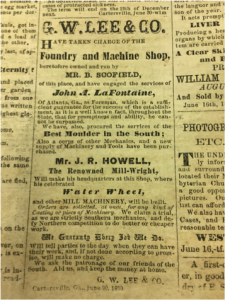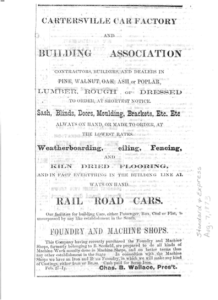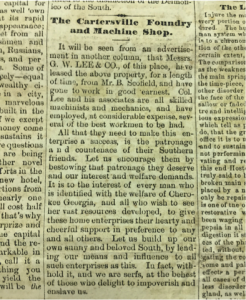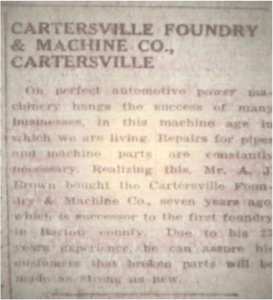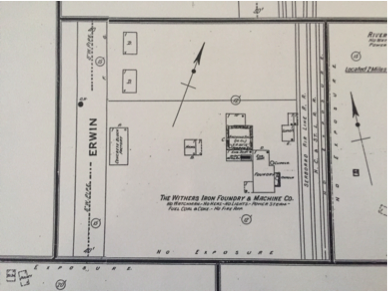The Last Family Foundry
A Look at Bartow’s Early Foundry Era
By Joe F. Head
Although no longer standing, perhaps the last remnant of the “Bartow Foundry Era” was the Cartersville Casting and Machine Company previously located at 148 and 155 Cassville Road. This property is described in Deed book 86, page 71 in the Bartow County Court House. (Land Lot 380, 4th District, plot 17 and Deed Book CC page 410)
If traveling north, it was located on the east side of Cassville Road across from present day Self Recycling south of ATCO next to the old Southern Air Line Railroad (SAL) spur about one block before reaching Erwin Street and Oak Hill Cemetery. Together, both lots are less than two acres in size and as of this writing are vacant serving only as two idle concrete pad storage areas.
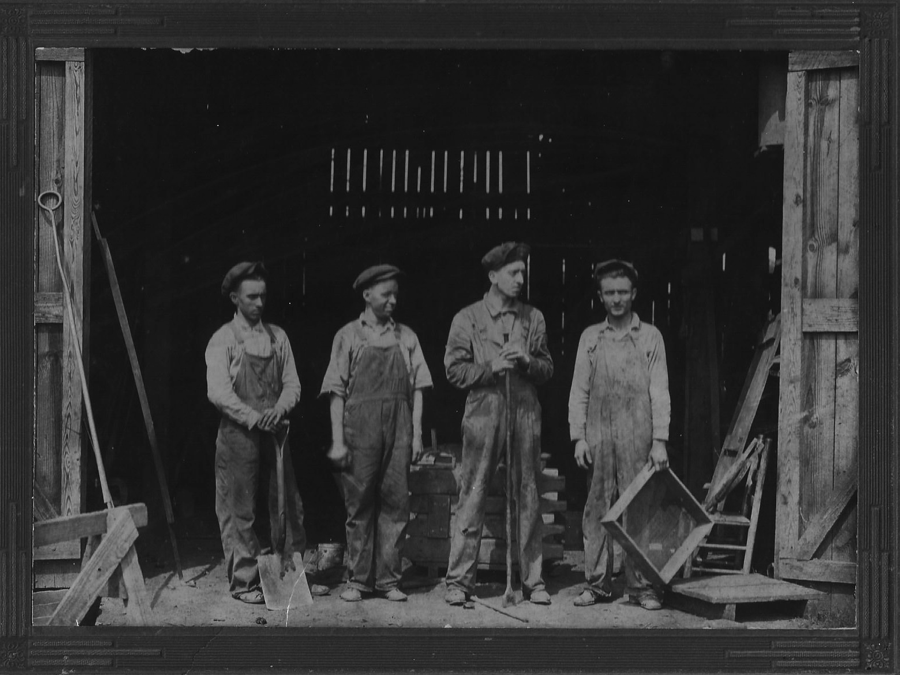
John Baker, second from left standing in main foundry door way. Circa early 1930’s.
After an extensive review of the deeds and records associated with this property it appears that John Baker and Milton Hill of Cartersville may have operated a Bartow foundry longer than any other owners.
Records indicate that John Baker leased the property in 1943 from Mrs. A. J. Brown (Granger Hill Subdivision) and then in partnership with Milton Hill and Walter Hill purchased the foundry in 1946 from Mrs. A. J. Brown and Mr. J. R. Shellhorse of Carterville. Baker and the Hill brothers were all brother-in-laws and truly were a family foundry business.
Ore mining became an unexpected industry that pushed into Cherokee lands of northwest Georgia as they initially extracted gold and then discovered iron and other profitable ores. Bartow (Cass) County has a long-standing history of mining and stone furnace ore smelting dating from the 1830’s. These stone furnaces are legendary to the county rising out of the earlier Dahlonega gold rush days that led to Cass/Bartow County.
The golden age of Bartow stone furnaces was circa 1830 to 1900. Stone furnaces are associated with iconic pioneer families that settled the county in the 1830’s. Among others the primary furnace families most often mentioned are Jacob and Moses Stroup, Mark A. Cooper and John W. Lewis. These stone cupola furnaces primarily were used to smelt iron ore, but also performed as a foundry to cast molded products. It was not uncommon to see a furnace serve both roles as needed.
These high profile furnace masters often formed partnerships and created railroads, such as the Etowah Railroad Company, Cherokee Railroad and Iron Belt Railroad to support iron production. Furnaces were first built on Stamp Creek and Etowah River. At its peak, Bartow was dotted with eleven stone furnaces and other similar rock furnaces or kilns that produced lead, lime and cement products.
Less celebrated in Bartow iron history is that of the “foundry age.” Multiple Bartow foundries appear in deed records and newspapers, but enjoyed little notoriety within Bartow’s golden age of mining and furnaces. With the exception of Mark A. Cooper’s Etowah River furnace and foundry the earliest records of a foundry are documented in county deeds and the 1868 Cartersville Express newspapers.
These subsequent foundries did not boast high profile pioneer family names. However, this research has uncovered a prominent name that points to a threaded line of foundries operated by a Mr. Bolivar Scholfield beginning in 1868. His association with multiple operations regarding partnerships, sales and foundry leases stands out among transactions.
Foundries actually became a natural progression of the furnace industry, but without the glamour. As raw iron ore was smelted it needed to be cast and shaped into useable products. Foundries specifically served this more technical role as opposed to pig iron furnaces, albeit some casting did take place at furnace sites. These foundries often produced wood burning stoves, cotton gin machinery, gears, pots, water wheels, hollow ware, axles, coal grates, boilers, plows and other farming implements. Some foundries also diversified advertising to offer sorghum, machinery repairs, brass and copper metals production.
Following the Civil War, industries in Bartow County suffered a severe setback. However, the local iron and mining industry rebounded quickly. The stone furnaces were put back into production and companies reformed. Enterprising men struck new contracts, found markets and cooperated with local miners to make liquid iron flow again.
Likewise, a cluster of approximately 12 casting foundries evolved primarily around the city of Cartersville. Tangled ownerships and missing records confuse if some of these operations were merged or if all stood as singular proprietorships. The following list is drawn from County deed records and local newspaper ads of the day.
1.Etowah Mft, Mining, Furnace & Foundry (Mark Cooper, 1845, Etowah Village)
2. Cartersville Foundry and Machine Shop (B. Scholfield, * 1868, Stonewall St)
3.W. Lee Foundry (Leased from B. Scholfield.* 1870)
4.Bartow Foundry and Machine Works (T. H. Withers, Erwin St. Junta RR, 1873)
5.Cartersville Car Factory and Foundry (Purchased from B. Scholfield,* 1873)
6.Etowah Foundry and Machine Shop (B. J. Lowman, 1877)
7.H. Hackett Foundry (Atlanta and Cartersville, 1878)
8.Georgia Foundry & Machine Co. (Taylorsville, date unknown)
9.Cartga Foundry Company (J. W. Vaughn, South Tennessee,1909)
10.Cartersville Foundry (Murray & Stevenson, 1881)
11.Cartersville Foundry & Machine Works (Summers & Jackson, Cassville Rd. 1925**
12.Cartersville Casting Co & Machine Shop (Baker & Hill, Cassville Rd. 1943 **)
Research reveals that these foundries typically had relatively short lives. They were often bought, leased, merged, renamed or foreclosed, making it difficult to track and sort out duplicate operations. The Cartga Foundry, 1909 to 1915 located south of Cartersville on Tennessee Street fronting the Western and Atlantic Railroad on land lots 552, 553 and 601 in the 4th District, 3rd section is an example of a foundry that experienced a rapid decline and sold to the Rhyme Brothers Lumber Company. Court house records contained in deed books RR, pages 449, 450 and book VV page 157, reflect sell off actions and further settlement by the Sherriff.
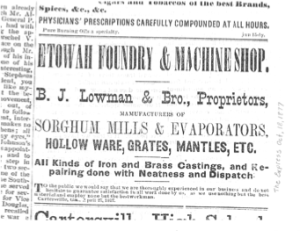

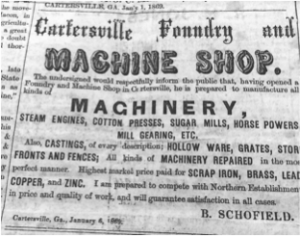
(All three foundries are similar in name, but under different owners. Ads found in Cartersville Express at the Bartow History Museum Archives)
The W. H. Hackett Foundry began in Cartersville. However, according to a newspaper article published in the Cartersville Express on June 15, 1877 gives notice that he will expand to Atlanta on 50 Broad Street and operate a Brass Foundry and Machine Shop.
Cartersville foundries flourished between 1870 and 1900 as a result of the mining and railroad industries. However, one surprising boost to the number of foundries was the unexpected rise of railroad car manufactures. Cartersville supported two such factories during this period and each needed foundries to cast wheels, frames, axles and other hardware to build cars. These factories would produce up to twenty five cars per week. The foundry operated by Murray and Stephensen was often associated with the Georgia Car Factory and the Scholfield Foundry was associated with the Cartersville Factory.
Entrepreneurs of the area recognized the vast Bartow mineral deposits and diverse resources concentrated in the county and were willing to invest large sums of money to exploit profits and develop new enterprises. According to a January 1889 article in the Kennesaw Gazette, Emerson also enjoyed the presence of a sizable foundry under the organization of the Emerson Malleable Iron Company. The article describes an operation with a main building of 160 feet by 64 feet housing offices, machine room, finishing room and all buildings covering over 10,000 square feet. Local foundry spirits were competitive. Advertisements often encouraged patrons to do business locally as opposed to northern options.
The Emergence of the Baker/Hill Cartersville Casting Co and Machine Shop
In 1923, two lots in the Howard survey near the furnace tract were purchased from Barbara Moore and family previously purchased from the Cartersville Land Company. Deed records reflect that a partnership was formed between J. Summers and J. W. Jackson who formed the Cartersville Foundry and Machine Works. By 1925 the partnership was expanded to include Mr. S. A. Merrell.
According to deed records the Cartersville Casting Company and Machine Shop and its ancestor company (as located on the same land) endured for about sixty years between 1923 and mid 1980. The Summers and Jackson foundry appear to be the origin of Bartow’s last family foundry owned by Baker and Hill.
A 1939 Tribune News article features Mr. A. J. Brown stating he bought the foundry some seven years earlier (1932) and he claims “it is the successor to the first foundry in Bartow County.” Eventually, Mrs. A. J. Brown and J. R. Shellhorse sold it to John Baker and the Hill brothers on August 31, 1946. Deed book 86, page 72 – 74 in the Bartow County Court House lists the terms of sale and a complete schedule of equipment to be transferred. (Mr. Brown’s reference to the Cartersville Casting Company as being the successor to the first foundry in Bartow County may have been an innocent stretch in light of research presented in this research paper)
Further evidence reveals that the oldest foundry was that of Mark Cooper in 1845 followed by the Cartersville Foundry and Machine Shop operating in 1868 by Mr. Bolivar Scholfield. It was later sold to the Cartersville Car Factory and Building Association in 1873 located on Tennessee and Main Streets. (See partial ads below)
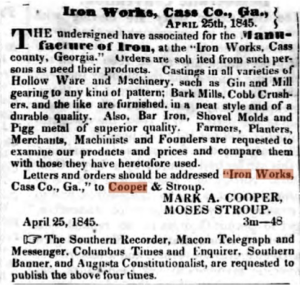
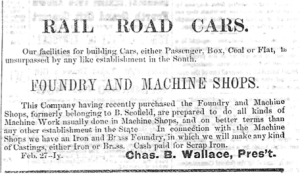
According to an interview with Mr. James Richard Blalock (aka, Buggy) the 1950’s foundry was a small operation of about six to eight employees. Mr. Blalock worked part time at the foundry as a teenager under Mr. John Baker. Baker grew up working in the foundry business beginning at about age fifteen. John was known as a very frugal person and remembered for his Tampa Nugget cigars.
Also, according to John Baker’s daughter, Joellen, following WWII Cartersville Casting received funding for a short time to teach the foundry business. She often worked in the foundry office handling paperwork and payroll.
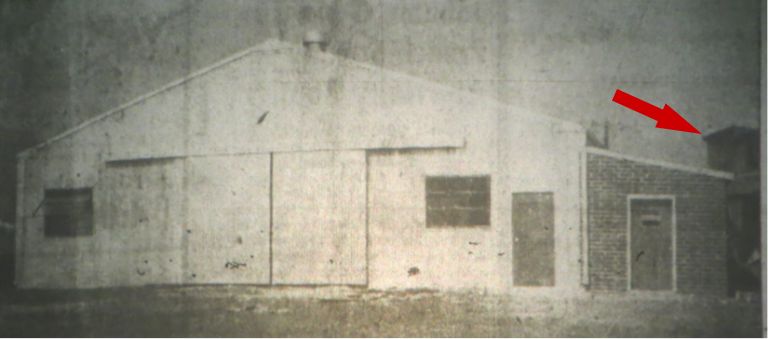
This photo of the machine shop appeared in the Weekly Tribune in 1958. The main wooden foundry structure can be slightly seen to the right. (Tribune News photo courtesy of Vickie Crow, Bartow Ancestors)
Foundry hours were 8:00am to 4:30pm five days a week with some Saturday hours. The original building was a two story, wooden barn like structure with a black dirt floor. As with most foundries it sat next to a railroad spur. The Cartersville Casting Company was served by the Southern Air Line (SAL spur) which served to deliver supplies and haul castings by rail to the main Western and Atlantic rail line.
The smelting schedule alternated on a bi-weekly operation. Three pours were scheduled for Monday, Wednesday and Friday on one week followed by two pours on the following week. The short week was used to clean the furnace, tools and prepare castings. Typical materials to be smelted were recycled scrap iron including engine blocks, sheet metal, cast plumbing pipe, old cast iron pots/pans, flat irons, washer lugs and various raw iron ores.
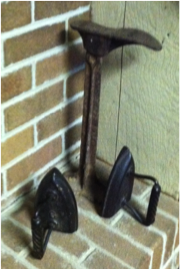
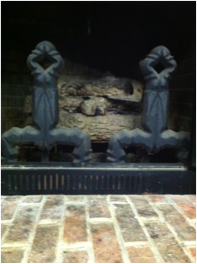

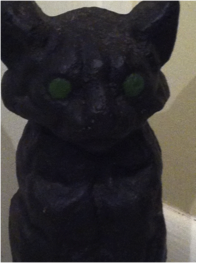
Examples of cast iron items that were recycled in the foundry. These items were salvaged by John Baker and given to his daughter, Joellen Baker Greene McKay
Mr. Blalock remembers the coke fired furnace and was told it came from Chattanooga, Tennessee. It stood about 20 feet in height and five feet in diameter. The cylindrical exterior was made of riveted cast metal plates with a brick lined
interior. The furnace sat on a base about three feet off the ground with a four-foot spout to allow for pour offs. Large hand ladles were used to catch the molten liquid and then poured into waiting casts.
A larger 500 pound ladle mounted on a portable rack with block and tackle was used for massive pours. Clay plugs were inserted at the spout base to stop the flow of liquid iron as ladles were changed out.
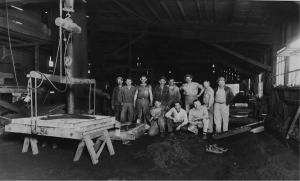
Standing third from left, James (Speedy) Blalock, Nat Cox, Sam Jarrett, far right John Baker standing and Milton Hill kneeling. The furnace and spout can be seen in the distant left behind the portable rack and men.
Cast shapes were prepared in advance by fashioning wooden molds and then placing them in square wood boxes of various sizes. Sand was packed around the wooden mold to develop the shape and then the wooden mold was removed leaving the shaped impression. A powder substance, known as pentene, was sprinkled on the sand molds. This was used to prevent moisture from damaging the sand cast shape once the pour started. Once the scrap metal had been fired and melted, a stringy liquid called slag would be drained off. These were the impurities that had separated from the liquid iron. Once slag cooled it assumed glass like qualities and when removed would break apart like brittle shards of glass that could injure one very easily.
According to Mr. Blalock, the foundry produced a variety of castings including;
bubblegum machine bases, storm water drain grates for highways, water meter boxes, gears, washers, and a vast number of custom items for the local mining industry. Mr. Mike Crow who also helped demolish the foundry, discovered military hand grenade casings and pipe couplers as well. Once items were poured they would be placed in the “rumbler machine” to smooth rough castings. After that they were placed in a “shot machine” to further refine the finish.
The machine shop was next door to the foundry and managed by Milton Hill. It was in a more modern metal building with tools that could finish semi-rough poured shapes, cut pieces, polish, cut screw threads or drill holes. It had a long shaft and pulley overhead to move heavy items. Among other services the shop made drive shafts, bushings, refit key way patterns and fabricated special orders for the mining companies.
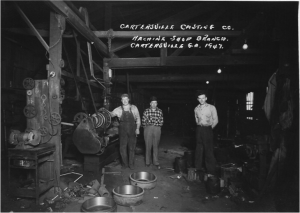 Left to right: Speedy Blalock, John Baker, Milton Hill in the 1947, former machine shop in rear of the foundry before the later 1958 metal building was constructed.
Left to right: Speedy Blalock, John Baker, Milton Hill in the 1947, former machine shop in rear of the foundry before the later 1958 metal building was constructed.
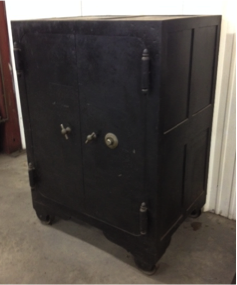
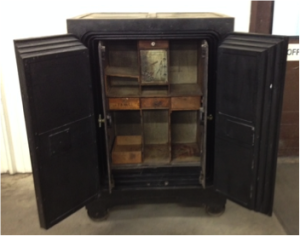
Employees and customers recall John Baker’s “Rome” safe that was located in the office. The safe is currently stored in the Stevens’ Southern Machine and Fabrications Shop. The Stephens family was the last to own and operate the foundry in the 1980’s.
Records reflect that the foundry was sold frequently. Also, the Cartersville Land Company was repeatedly involved in a number of earlier transactions as buyer, owner and/or seller of the property. A number of lesser family owners and interest holders included Merrell, Craig, Hood, Clayton and others. In 1952 Baker and Hill completed an effort to buy up all the property real estate deeds in order to bring all the lots under the foundry’s name. (The owners and foundry names were often confused in transactions.)
Suspected sequence of Cartersville Casting Company foundry ownership
- Land Lot 380, 4th District, plot 17
- 1923 Cartersville Land Company to J. Summers and J. W. Jackson Deed Book 60, p 465, (Cartersville Foundry & Machine Co.)
- 1925 S. W. Merrell and Cartersville Foundry and Machine Works partnership with J. Summer and J. W. Jackson (former Barbara Moore property) Book 63, page 60
- 1931 J. Jackson and J. Summers to A. J. Brown and R. L. Bigham (Alabama) Deed Book 68, Page 386
- 1943 Mrs. A. J. Brown leases property to John Baker
- 1946 Mrs. A. J Brown and J. R. Shellhorse to John Baker, Milton Hill and W. C. Hill. (Deed Book 86 Page 75, 8/31/46)
- 1946 Mrs. A. J. Brown to Baker and Hill brothers. Book 86 pages 73-75 including an inventory of equipment.(8/31/46, Second transaction for $1.00), recorded in deed book CC, page 410)
- 1952 W. C. Hill sells to John Baker and Milton Hill (Deed Book 98, page 417)
- 1958 Baker and Hill convey property to Cartersville Casting Co. (Deed Book 115 page 111)
- 1966 Baker and Hill structure a sell in 1966, to Charles and Frances Kelley, Cobb County. Debt to be settle by 12/1/69 (Deed Book 159 page 77)
- Michael Stephens (Southern Machine Shop)
- Steve and Francis Cowart (Kingston)
Conclusion
Today Bartow County still has an iron industry presence, albeit in the form of international operations such as Gerdau Ameristeel a German company.
The Southern Machine and Manufacturing Company was the last owner of the Cartersville Casting Company and eventually demolished the buildings in the mid 1980’s. The land was sold to Self Recycling and is owned at the time of this writing by Steve and Francis Cowart of Kingston, Georgia.
Now only a memory, the Cartersville Casting Company represents the “last man standing” among the foundries that once stood in Bartow County. Clearly over a half century of operation beginning in the 1923 made it the longest running foundry in the county and final chapter of a family owned foundry.
This obscure piece of county history deserves a brief showcasing as it adds yet another chapter to Bartow’s proud furnace heritage. As a result, John Baker and Milton Hill may be a modern age throw back to early foundry masters and the golden age of the Bartow furnace industry.
As a footnote to the foundry legacy in Bartow County, it should be noted that a proposal was submitted to the 29th Congress on February 10, 1846 by former Georgia Governor, John Lumpkin. His effort was to establish a National Foundry site in Bartow County. (House of Representatives, Bill No. 202, Rep. Archibald Yell) The proposal introduction is offered below. It appears the proposal was never ratified.
“I have the honor to inform you that the proposed location in Georgia, for a national foundry is in Cass County, on the Etowah River, at or near the point where the Western and Atlantic railroad crosses that stream. “
This attempt to recognize the value of foundries further underscores the importance of the furnace and ore industry in the Etowah Valley.
Sources
Interviews:
Blalock, James Richard(Buggy), Cartersville, GA, November 22, 2014 (former employee)
Crow, Mike and Vickie, Cartersville, GA November 24, 2014 (former employee)
McKay, Jollen Baker, Greene: Kingsport, TN, October 3, 2014 (daughter of John Baker)
J. B. Tate, KSU Retired, Cartersville, GA November 22, 2014
Acknowledgements :
Bartow History Museum Archives
Crow, Vickie, Bartow Ancestors
Etowah Valley Historical Society Archives
Gentry, Lynne, Bartow County Deeds and Records
Prewett, Jerry and Peggy, Cartersville, GA.
Stephens, Mike, Southern Machine Shop, Cartersville, GA
Tate, J. B. , Cartersville, GA
County Records, Residential Directory and News Publications
Deed Books, Bartow County Court House
Writ Books, Bartow County Gold Dome Court House, EVHS Office
Tribune News, 1939, 1958
Kennesaw Gazette, January 1889, page 3
Courant-American, 1889
1883-84 Cherokee/Cartersville Resident Directory
The Federal Union (Milledgeville) March 10, 1846, National Foundry
The Southern Recorder, April 25, 1845, Macon Telegraph, GA
Standard & Express, August 7, 1873
Cartersville Express, March 20, 1924
Cartersville Express, June 15, 1877
Cartersville Express Newspaper ads circa 1870 – 73
